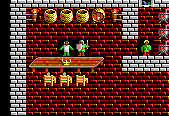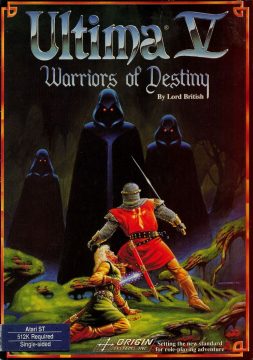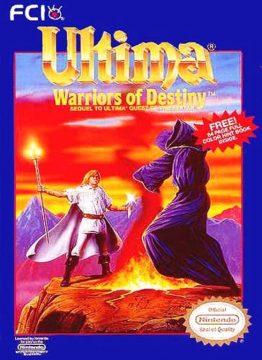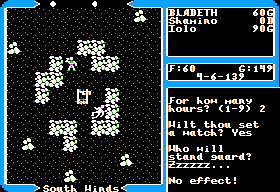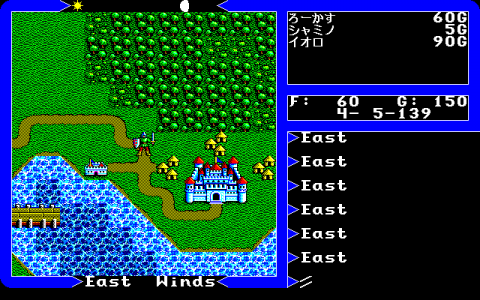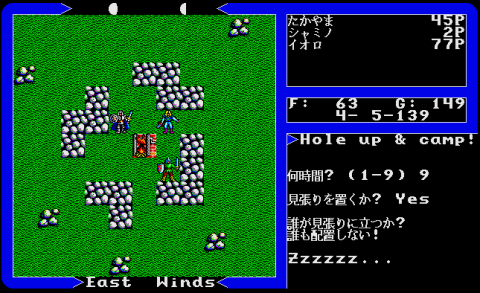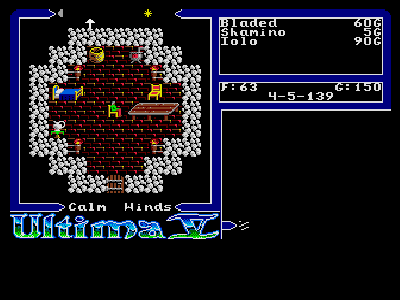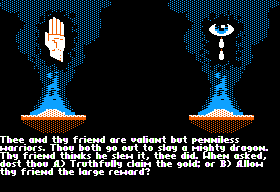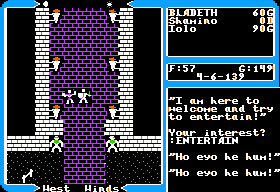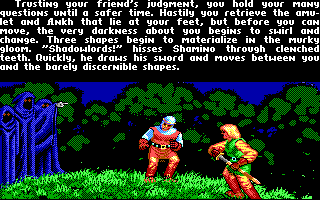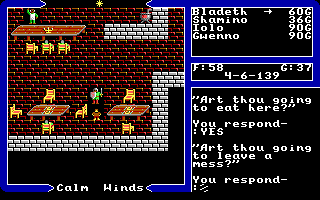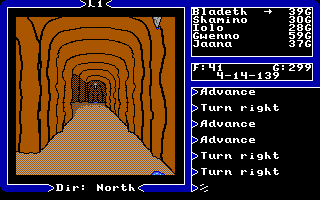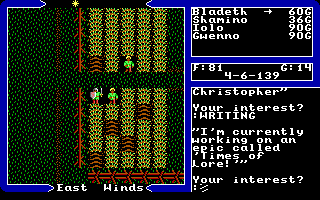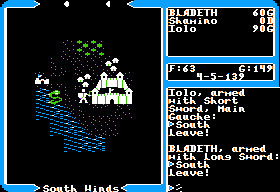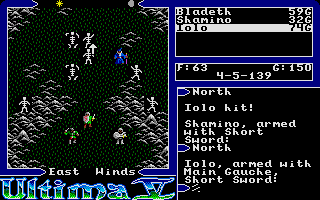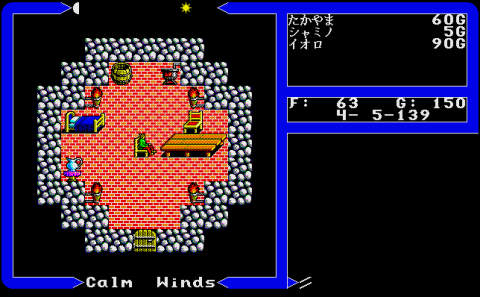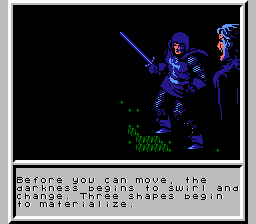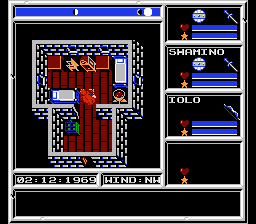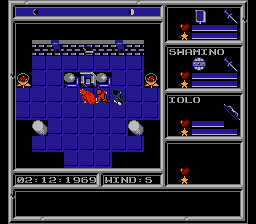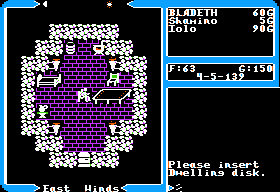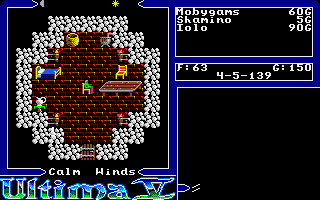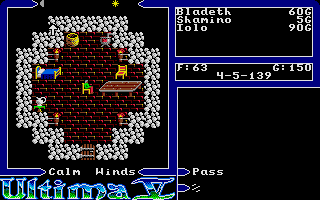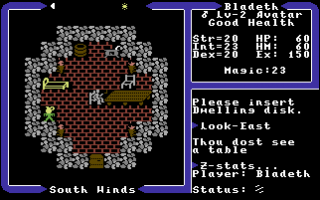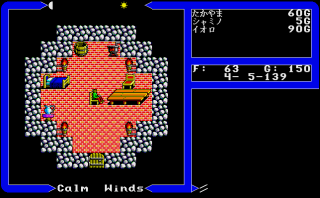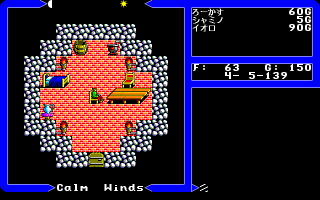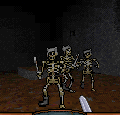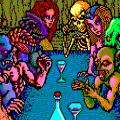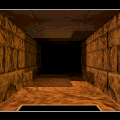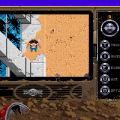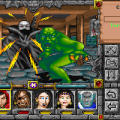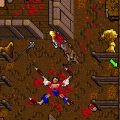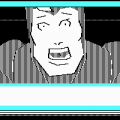- Ultima (Series Introduction)
- Akalabeth
- Ultima I: First Age Of Darkness
- Ultima II: Revenge of the Enchantress
- Ultima III: Exodus
- Ultima IV: Quest Of The Avatar
- Ultima V: Warriors of Destiny
- Ultima VII: The Black Gate
- Ultima VI: The False Prophet
- Ultima VII Part 2: Serpent Isle
- Ultima VIII: Pagan
- Ultima Underworld: The Stygian Abyss
- Ultima Underworld II: Labyrinth of Worlds
- Arx Fatalis
- Worlds of Ultima: The Savage Empire
- Ultima Worlds of Adventure 2: Martian Dreams
- Ultima IX: Ascension
- Lord of Ultima
- Ultima Online
- Ultima: Escape from Mt. Drash
- Ultima: Miscellaneous
- Richard Garriott (Interview)
Something arouses you in the dead of night. Your eyes snap open, and in your bedroom you see an apparition floating in midair; the Symbol of the Avatar! Does Britannia have need of you once more? Hastily, you gather your belongings and rush outside, hoping against hope that once again you can leave Earth for the lands you worked so hard to inspire, the lands of Lord British and of your beloved friends. A moongate is there! With beating heart, you step inside… to find your old companion Shamino the ranger under attack by three mysterious, towering beings of darkness. They spot you, and take aim, but the ranger throws himself in the path of the bolt, taking the hit meant for you. You retreat, and stumbling upon a hidden hut deep in the words, find Iolo the Bard, who tends to the ranger and tells you the sad tale of what has become of Britannia. Lord British is missing, a tyrant named Blackthorn has instituted a terrible law enforcing his version of the ‘virtues’, and Britannia lives in a new day of darkness. Your course is clear: find Lord British, depose Blackthorn, and once again be the Avatar that the Britannian people cry out for!
Ultima V: Warriors of Destiny, sixth installment in the series, is a major step up from previous Ultima games in many ways, and it’s difficult to recognize the first ages of darkness here in such a highly polished piece of software. The most immediately obvious change is the new-found depth of the storytelling and the complexity of the game’s plot. Ultima V is a much darker and mosiac game than Quest of the Avatar, which is made immediately obvious in the introduction. Lord British is missing, and in his stead the tyrant regent Blackthorn has taken it upon himself to ‘enforce’ the Eight Virtues in a draconian manner, rewriting them to fit his law. In Garriott’s own words, “Ultima IV: Quest of the Avatar had to do with personal virtue. And Ultima V: Warriors of Destiny was my story about the ills of the legislation of morality”.
Blackthorn’s Code of Virtue
Honesty – Thou shalt not lie, or thou shalt lose thy tongue
Compassion – Thou shalt help those in need, or thou shalt suffer the same need
Valor – thou shalt fight to the death if challenged, or be banished as a coward
Justice – Thou shalt confess to thy crime and suffer thy punishment, or be put to death
Sacrifice – Thou shalt donate half thy income, or thou shalt have no income
Honor – If thou dost lose thy honor, thou shalt take they own life.
Spirituality – Thou shalt enforce the laws of virtue, or thou shalt die as a heretic
Humility – Thou shalt humble thyself to thy superiors, or thou shalt suffer their wrath.
Ultima V convincingly portrays a society living under the yoke of moral fundamentalism, where ethics are enforced by rule of law. Warriors of Destiny dares to ask and try to answer whether the right thing and the wishes of the law are always the same, and does so with grace and panache under a thrilling fantasy story. Assisting this is a much expanded script, where each NPC has many more things to say than in previous games. Your old Companions are still around, and eager to join your resistance against the Tyrant. In this game, they feel more like people with personalities than before, and you’ll need them, for there’s more going on than just a corrupt police state; whether through talk with the townspeople or by bad luck, the cause of Britain’s descent and Blackthorn’s corruption is made clear fairly early on. Three mysterious beings, the Shadowlords, are at work in Britannia. Each Shadowlord represents the antithesis of one of the principles of Truth, Love and Courage: Falsehood, Hatred and Cowardice, and their presence negatively influences people. Visiting a town with an aura of fear or simmering anger in the air is a bad idea, for the Shadowlords plague the towns and cities of Britannia and the mere presence of one will drive the people into madness, causing them to steal from you, or attack you, or run away in fear. The ultimate goal of the game is to find a way to destroy these Shadowlords, and discover their connection with the rise of Blackthorn and disappearance of Lord British.
Not just a major advance in storytelling, Warriors of Destiny is also the most vibrant and detailed game in the series yet. The graphics are absolutely outstanding. Ultima V was the last game in the series to use the old-fashioned square tile graphics, but they go out with a bang, with very detailed animations, a great variety of objects and furnishings to interact with in the world and more variety in the graphics in general. Ultima V adds a ‘look’ command to the list of available actions, which will display a short description of whatever is in front of the player, a simple addition greatly adding to the world’s sense of life. Signs (written in runic script) can be read, torches can be ‘borrowed’, barrels can be scrouged in, food lying on tables can be stolen if you’re hungry (though tis’ not a moral thing to do, Avatar). Chairs can actually be sat in, and beds can be used; the game will show animations of the characters doing so if you move onto them.
While the phases of Britannia’s moons already existed in previous games, Ultima V adds an entire day/night cycle, and in a feature largely unimplemented in other CRPGs since, NPC schedules. People will wander town during the day and sleep at night, and at the midnight hour getting into guarded towns can be a challenge, necessitating the use of secret paths and back-doors; never forget that in this Britannia, you’re a fugitive from the law. The system of Britannian Runes, a cipher based on Germanic runes and used primarily on the cloth maps of earlier games, now appear in-game on signs and in conversation, invoking a touch more detail to this imaginary world and simultaneously serving as a form of copy protection.
This sixth installment in the series is also the last gasp for Ultima‘s first-person-view dungeon crawling, but it goes out well. Rather than vector lines or flat panels, Warriors of Destiny’s obligatory dungeons are in full color, with textures like worn stone, chained skeletons and brown stalagmite-filled rock. The monsters in first-person view are now full color beasts rather than simple vector lines or blown-up overworld icons. The one notable step backwards in complexity is the character classes, which for this game only number four for some reason: Avatar (that’s you), Fighter, Bard and Mage. This leads to the occasional graphical quirk such as our old companion Jaana the Druid having a luxurious gray beard in this installment of the game, as there aren’t separate male and female graphics for the classes.
Starting with Ultima IV, the ever-changing game world of Sosaria became the more consistent Britannia, and for the rest of the series Britannia is the same basic world with the same geographical layout. (As a direct result of this, the cloth maps from Ultima IV onward can be used fairly well with any later entry in the series). Being familiar with Quest of the Avatar provides a strong advantage for fans, rewarding the player by letting them see how familiar locales and people grow and change over time. For instance, the forest city of Yew has become less isolated and more urbanized, and now has a road running from it to the castle of Empath Abbey, making it much easier to navigate the northwest woods. Familiarity with Quest of the Avatar also makes it easier to orient yourself and figure out what to do and where to investigate next, as well as helping to solve some of the game’s puzzles. The locations of towns and shrines are largely the same, and the same mantras and passwords still work.
Combat here is also far more entertaining than in previous games thanks to the two welcome additions of individual hands and the ability to aim in non-cardinal directions. A character can equip a two-handed weapon, two one-handed weapons, or a one-handed weapon and a shield, and since classes are not limited in their weapon choices this results in a large amount of party equipment customization. Using those weapons is easier than ever too, thanks to the addition of the aiming mechanic. Now melee fighters can hit diagonally instead of just up, down, left and right, and ranged fighters and magicians can hit any target in range. There are many more rewards per fight as well. Rather than the single treasure chest left on the overworld of the last two games, every individual monster has a chance of dropping a chest, and each chest can contain gold, food, torches, keys and equipment all in the same box instead of simply a gold payout. This makes the slower combat pace more tolerable by increasing rewards, in addition to the lessened focus on combat in the first place; random encounters on the overworld are rare during the day and monsters can be avoided fairly easily at night, making combat almost always optional. There, again, isn’t a “final boss” fight as such; Blackthorn and the Shadowlords must be stopped with cunning and not force of arms. In terms of game mechanics and world-building, Ultima V is a serious advance on its predecessor, continuing the series tradition of notable technical and storytelling improvement with every entry.
Warriors of Destiny, like Quest of the Avatar, includes extensive feelies in the packaging. Similar to Quest of the Avatar‘s ankh amulet, Warriors of Destiny includes a metal Codex medallion like the one from the game introduction, a metal disc with the mark of the Codex of Ultimate Wisdom. In addition, the game surpasses itself with extensively detailed documentation, containing no less than three manuals each written and presented as in-universe documents. The game ‘manual’ is a detailed Britannian guidebook, written in the style of a travel guide and containing information on Britannia’s geography, towns, people, available food and services and detailed history of the realm. Players also get a ‘spellbook’ written as a textbook primer for young mages that goes into great detail about the mechanics of magic, and the expedition journal of Lord British, documenting the ill-fated trip that resulted in his disappearance. Much of the material in these books is directly relevant to gameplay, giving veiled clues and hints (particularly the spellbook, which the magic system cannot be understood without) and is an outstanding show of the care and attention to detail that Origin Systems was known for.
Warriors of Destiny is the first game in the series to not be programmed in the near entirely by Richard Garriott, with the work being split up between Origin Systems’ now quite large programming staff in an effort to help the game get released faster despite the layers of added complexity. Primary programming was done by John Miles, who appeared in-game as the pirate Captain Johne, and later went on to code the Miles Sound System, still the most popular piece of game development middleware ever written. It was also the last game to be developed first on the Apple II platform. By 1987 the limitations of 8-bit computers and the Apple II platform in particular were impossible to ignore, and 16-bit systems like the Apple Macintosh, Commodore Amiga and IBM PC were rapidly taking over the market. Other than a stripped-down Commodore 64 port of Ultima VI, is the last game in the series to be published for 8-bit computers. Richard Garriott decided during porting work of Ultima V to finally drop support for the Apple II as a development platform; according to John Romero (Doom, Quake), who was an employee of Origin at the time the ports for Warriors of Destiny were being written, Richard Garriott did this for sales reasons: the PC was absolutely stomping the Apple II by 1988 in sales and 8-bit computers were well on the way out. A lesser reason for the dropping of the Apple II may also have been Garriott’s interest in the colorful EGA graphics available on the game’s IBM PC version; the platform certainly offered a much better visual experience than the Apple II would ever be capable of. The results would be dramatic.
The Apple II version requires extra RAM and a sound card, but isn’t actually as terrible as would be expected of a game that pushes the hardware’s limits to the breaking point. It is, however, clearly the inferior version of the game, with strange colors and very poor graphics. The Commodore 64 version programmed by David “Dr. Cat” Shapiro has improved colors but a host of technical issues, including problems with the loader that causes PAL region C64s to load the game ungodly slowly, and most infamously the machine does not have enough memory to play the musical score (playing the game on a Commodore 128 machine alleviates both the loading and music issues). An Atari 8-bit port written by Rob Satonica exists, but is unfinished and unreleased; disk images of the player and boot disks exist on the internet, but without the third ‘Britannia’ disk the game cannot actually be played past the title screen.
The 16-bit ports of Warriors of Destiny, including the IBM PC version, are almost completely identical to each other save for the lack of mouse control in the PC edition. The mouse was still an optional component for PC platforms in 1988 and so yet again DOS gamers miss out. The only other real other difference between the 16-bit platforms is in the music. The Amiga version loops the same track for most of the game, while the Atari ST has the full Apple II/Commodore 128 soundtrack but the music is played in different places than in the 8-bit versions. The DOS version has no music, because while sound cards were finally available for IBM PC machines around this time they were still very uncommon. As with the previous few games, Ultima’s fans have stepped up to the plate and offered an upgrade patch for the DOS port which adds in the full music score from the 8-bit ports. With this patch, the DOS port is arguably the best available version of the game.
Pony Canyon’s Sharp X68000 and NEC PC-98 versions are indistinguishable from each other, and like their previous releases in the series are drawn using the same brightly-colored, anime-like substitution tileset. No versions for the less powerful Japanese computers were ever released, resulting in far fewer available versions of Ultima V than Ultima IV. Fujitsu’s FM Towns version is on par with the western 16-bit editions, with identical graphics, the advantage of CD-quality audio and the ever-present FM-Towns exclusive introduction movie. Unusually, this game seems to have been released after the FM Towns version of Ultima VI.
Like the previous two games in the series, Warriors of Destiny received a console port to the Nintendo Entertainment System. This version is an ambitious remake from the ground-up with many changes to graphics and play mechanics resulting in an almost totally new game. The design philosophy seems to have been to make the game play as close as possible to Ultima VI, with the same sort of isometric viewpoint and art style and includes character portraits, a feature lacking in the original Warriors of Destiny. Even the world of Britannia is seamless between overworld, town and dungeon, one of the defining features of Ultima VI and later games. This may have been influenced by the desire to create something that didn’t seem incongruous from the SNES port of Ultima VI, released a year earlier. Pulling all this off on the rather underpowered (and in 1993, technologically ancient) NES was an impressive achievement, but the game itself is anything but.
The NES Warriors of Destiny is legendarily bad, and that isn’t a subjective opinion. The majority of the game’s impressive writing has been cut severely for space; in previous games this wasn’t so bad, but the script is probably the game’s primary appeal, and without it the entire experience falls flat. The NES struggles to run this program, with walking speed agonizingly slow and an aggravating delay between every button press and the command actually being executed. The low resolution of the NES results in the Ultima VI-style graphics being grainy, muddled and far, far too dark. Not only is it impossible to tell what you’re looking at half the time, Britannia’s overall size and complexity has been drastically reduced and there isn’t much worth looking at in the first place. Other cuts and reductions to the game are legion, including the lack of an ability to name your character, a truncated introduction, lack of sound effects and apparently only one (grating) music track in the whole game, and a total absence of horses in the entirety of the realm, save for everyone’s favorite NPC Smith. (Conversation reveals that hungry people have eaten them all, an excuse that will at least make fans of the Bethesda RPG Morrowind grin). This game was released with an oversized manual like other NES RPGs that also functioned as a cluebook and walkthrough.
In 2008, Ultima fan David Randall completed a port of Warriors of Destiny to the Texas Instruments TI-89 and TI-92 calculators. This version, while at a smaller resolution and in monochrome, is a faithful port, translating all the game’s complexity including NPC daily schedules and full dialogue, surely resulting in many Ultima fans failing to pass their statistics courses.
Comparison Screenshots
Links:
Purchase Ultima V: Warriors of Destiny at gog.com
Game maps and walkthrough, and transcription of Lord British’s expedition journal
Complete game script by Andrew Schultz
Project page for the Ultima V IBM PC upgrade.
Replacement for the NES version’s documentation
Ultima V for TI-89 and TI-92 calculators
Listing and download for the incomplete Atari 8-bit port
